For the 2025 school year, there are 2 public preschools serving 759 students in Lunenburg County School District. This district's average pre testing ranking is 2/10, which is in the bottom 50% of public pre schools in Virginia.
Public Preschools in Lunenburg County School District have an average math proficiency score of 35% (versus the Virginia public pre school average of 55%), and reading proficiency score of 55% (versus the 66% statewide average).
Minority enrollment is 58% of the student body (majority Black), which is more than the Virginia public preschool average of 56% (majority Hispanic and Black).
Overview
This School District
This State (VA)
# Schools
4 Schools
1,059 Schools
# Students
1,582 Students
522,218 Students
# Teachers
120 Teachers
37,218 Teachers
Student : Teacher Ratio
13:1
13:1
District Rank
Lunenburg County School District, which is ranked within the bottom 50% of all 135 school districts in Virginia (based off of combined math and reading proficiency testing data) for the 2020-2021 school year.
The school district's graduation rate of 80-84% has stayed relatively flat over five school years.
Overall District Rank
#109 out of 135 school districts
(Bottom 50%)
(Bottom 50%)
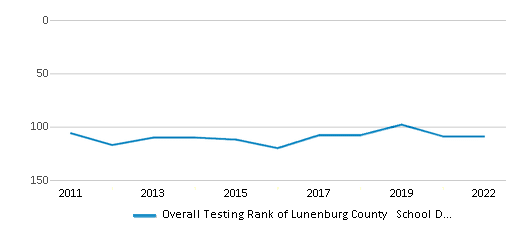
Math Test Scores (% Proficient)
(20-21)33%
54%
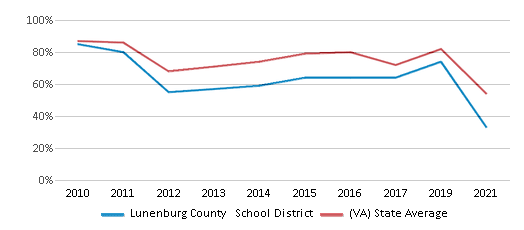
Reading/Language Arts Test Scores (% Proficient)
(20-21)60%
69%
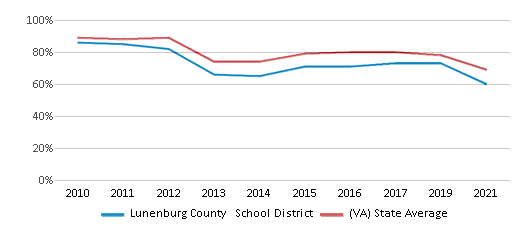
Science Test Scores (% Proficient)
(20-21)48%
59%
Graduation Rate
80-84%
89%
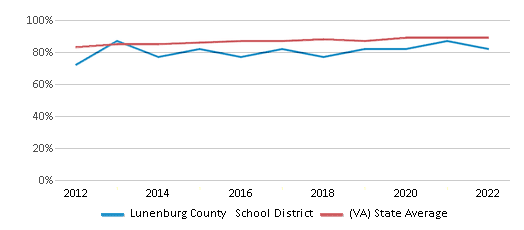
Students by Ethnicity:
Diversity Score
0.66
0.72
# American Indian Students
4 Students
1,435 Students
% American Indian Students
n/a
n/a
# Asian Students
4 Students
42,355 Students
% Asian Students
n/a
8%
# Hispanic Students
248 Students
104,836 Students
% Hispanic Students
16%
20%
# Black Students
504 Students
103,630 Students
% Black Students
32%
20%
# White Students
741 Students
231,144 Students
% White Students
47%
44%
# Hawaiian Students
3 Students
693 Students
% Hawaiian Students
n/a
n/a
# Two or more races Students
78 Students
38,125 Students
% of Two or more races Students
5%
8%
Students by Grade:
# Students in PK Grade:
71
34,291
# Students in K Grade:
115
76,338
# Students in 1st Grade:
124
80,198
# Students in 2nd Grade:
130
82,775
# Students in 3rd Grade:
119
74,941
# Students in 4th Grade:
99
76,158
# Students in 5th Grade:
101
74,304
# Students in 6th Grade:
114
13,434
# Students in 7th Grade:
112
1,615
# Students in 8th Grade:
107
653
# Students in 9th Grade:
125
1,849
# Students in 10th Grade:
134
1,917
# Students in 11th Grade:
106
1,904
# Students in 12th Grade:
125
1,841
# Ungraded Students:
-
-
District Revenue and Spending
The revenue/student of $13,235 in this school district is less than the state median of $15,502. The school district revenue/student has stayed relatively flat over four school years.
The school district's spending/student of $13,049 is less than the state median of $15,257. The school district spending/student has stayed relatively flat over four school years.
Total Revenue
$21 MM
$19,496 MM

Spending
$21 MM
$19,187 MM
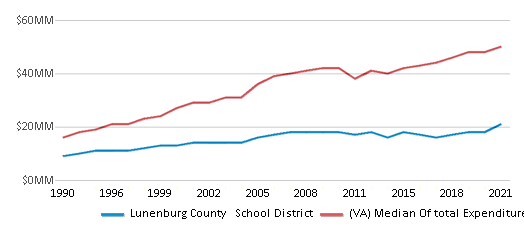
Revenue / Student
$13,235
$15,502
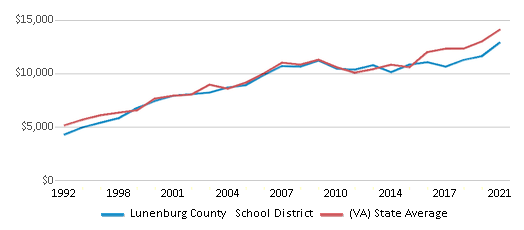
Spending / Student
$13,049
$15,257

Best Lunenburg County School District Public Preschools (2025)
School
(Math and Reading Proficiency)
(Math and Reading Proficiency)
Location
Grades
Students
Rank: #11.
Victoria Elementary School
(Math: 35-39% | Reading: 55-59%)
Rank:
Rank:
3/
Bottom 50%10
1521 Eighth St
Victoria, VA 23974
(434) 696-2163
Victoria, VA 23974
(434) 696-2163
Grades: PK-5
| 400 students
Rank: #22.
Kenbridge Elementary School
(Math: 30-34% | Reading: 50-54%)
Rank:
Rank:
2/
Bottom 50%10
215 Nottoway Falls Rd
Kenbridge, VA 23944
(434) 676-2491
Kenbridge, VA 23944
(434) 676-2491
Grades: PK-5
| 359 students
Recent Articles

Year-Round Or Traditional Schedule?
Which is more appropriate for your child? A year-round attendance schedule or traditional schedule? We look at the pros and cons.

Why You Should Encourage Your Child to Join a Sports Team
Participating in team sports has a great many benefits for children, there is no doubt. In this article you will learn what those benefits are.

White Students are Now the Minority in U.S. Public Schools
Increasing birth rates among immigrant families from Asia and Central and South America, combined with lower birth rates among white families, means that for the first time in history, public school students in the United States are majority-minority. This shift in demographics poses difficulties for schools as they work to accommodate children of varying language abilities and socio-economic backgrounds.





